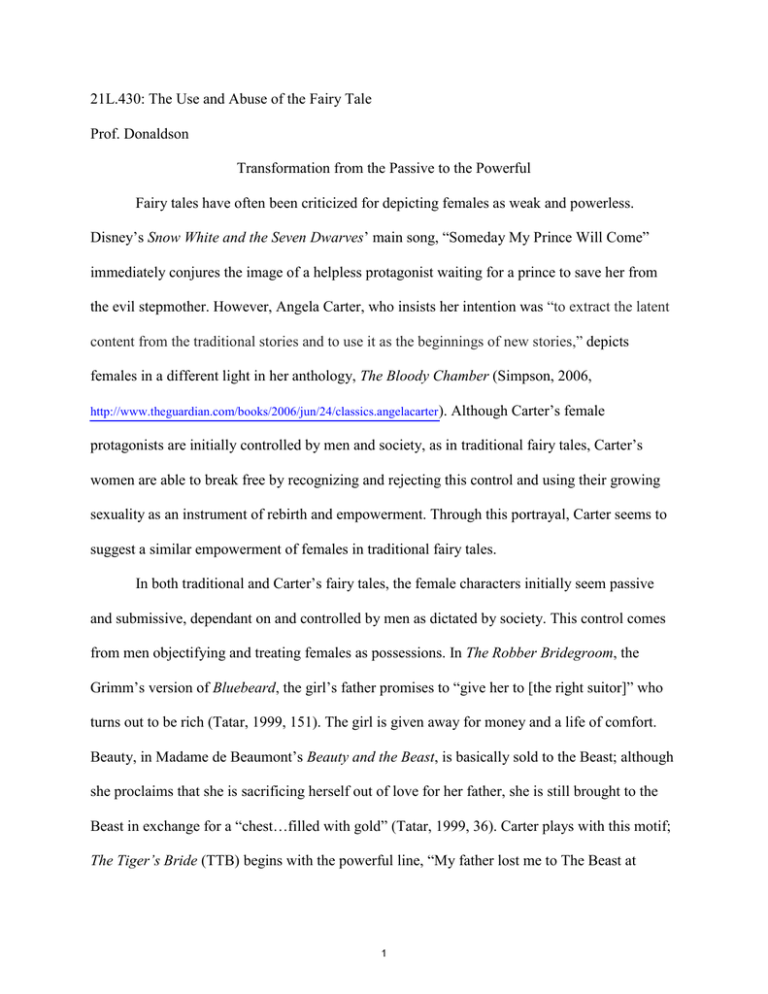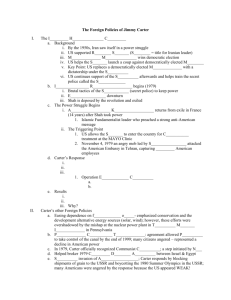
21L.430: The Use and Abuse of the Fairy Tale
Prof. Donaldson
Transformation from the Passive to the Powerful
Fairy tales have often been criticized for depicting females as weak and powerless.
Disney’s Snow White and the Seven Dwarves’ main song, “Someday My Prince Will Come”
immediately conjures the image of a helpless protagonist waiting for a prince to save her from
the evil stepmother. However, Angela Carter, who insists her intention was “to extract the latent
content from the traditional stories and to use it as the beginnings of new stories,” depicts
females in a different light in her anthology, The Bloody Chamber (Simpson, 2006,
http://www.theguardian.com/books/2006/jun/24/classics.angelacarter ).
Although Carter’s female
protagonists are initially controlled by men and society, as in traditional fairy tales, Carter’s
women are able to break free by recognizing and rejecting this control and using their growing
sexuality as an instrument of rebirth and empowerment. Through this portrayal, Carter seems to
suggest a similar empowerment of females in traditional fairy tales.
In both traditional and Carter’s fairy tales, the female characters initially seem passive
and submissive, dependant on and controlled by men as dictated by society. This control comes
from men objectifying and treating females as possessions. In The Robber Bridegroom, the
Grimm’s version of Bluebeard, the girl’s father promises to “give her to [the right suitor]” who
turns out to be rich (Tatar, 1999, 151). The girl is given away for money and a life of comfort.
Beauty, in Madame de Beaumont’s Beauty and the Beast, is basically sold to the Beast; although
she proclaims that she is sacrificing herself out of love for her father, she is still brought to the
Beast in exchange for a “chest…filled with gold” (Tatar, 1999, 36). Carter plays with this motif;
The Tiger’s Bride (TTB) begins with the powerful line, “My father lost me to The Beast at
1
cards” (Carter, 1979, 51). Not only is Beauty treated as an object to be passed back and forth, but
also an object that has no feelings or soul. In fact, Beauty explains that because she is female,
“men denied [her] rationality… [and] all the best religions in the world state categorically that
not beasts nor women were equipped with the flimsy, insubstantial things [as souls]” (Carter,
1979, 63). Society, more specifically a male dominated society, declares that women are no more
than beasts without reason or soul. Instead, they become objects of desire; they are something
that men have bought and use to satisfy themselves. In The Bloody Chamber (TBC), the girl
admits, “I knew I had behaved exactly according to his desires; had he not bought me so that I
should do so?... I had played a game in which every move was governed by a destiny as
oppressive and omnipotent as himself, since that destiny was himself; and I had lost” (Carter,
1979, 34). Again, the motif of buying and selling women as objects is evident, and the girl makes
more explicit that she had been bought “according to [her husband’s] desires.” She becomes an
object on which her husband can implement his desires (sexual or violent) with no thoughts or
feelings of her own. Her husband owns her completely and freely manipulates her fate. Her
passivity is even echoed in the storytelling. Her actions are direct responses to her husband’s
orders; he commands her to “kneel! [so she] knelt before him” (Carter, 1979, 36), tells her to
bathe, and she does so, calls her to him, “so [she] must go to …where [her] husband waited”
(Carter, 1979, 38). Her actions are almost mechanical with no feelings, and the language echoes
the emotionless, obedient call and response.
However, Carter’s heroines, by realizing their own passivity and discovering the power
of their own sexuality, break free of male as well as societal control. The girl in TBC begins to
question her destiny, asking, “‘who can say what I deserve or no?' ‘I've done nothing; but that
may be sufficient reason for condemning me.'…'I only did what he knew I would'” (Carter, 1979,
2
37-38). From the beginning, her husband expected her to fail, forcing this fate upon her;
however, by questioning the right for the Marquis to control her and her fate, she empowers
herself. This transition from passive to powerful is also reflected in the language. Triggered by
her mother’s arrival, the protagonist gains a mind of her own, “The blade did not descent, the
necklace did not sever, my head did not roll… [The Marquis’] astonished indecision… let me
spring upright and dart to the assistance of my lover” (Carter, 1979, 39). The aggressive tone and
repetitive use of “did not”’ emphasizes the contrast from the previous obedient voice. She finally
contests her husband’s decided fate for her, even actively helping her lover to escape. Comparing
herself to dolls that “break free of their strings… and start to live for themselves,” she also gains
a mind and life of her own and rejects the control of her husband (Carter, 1979, 39). After the
death of her first husband, the protagonist is reborn as a new woman, choosing Jean-Yves as a
lover, (interestingly, her choice of blind lover, results for a change, in the male being dependent
on the female) and making a new life for herself without the Marquis’ corrupted wealth.
Beauty in TTB also realizes that all her life she has been but a puppet to her father;
however, through her choice to remain with her lover, the Beast, she escapes the confines of
society. She realizes that she “had been bought and sold, passed from hand to hand...had [she]
not been allotted only the same kind of imitative life amongst men that the doll-maker had given
[the doll]?” (Carter, 1979, 63). By comparing herself to her doll-maid, Beauty acknowledges
society and men’s objectification of her. The word-choice of “allotted…life” echoes the
Marquis’ control over his wife’s fate in TBC as well as the doll-like, obedient state of the wife.
Similarly, Beauty is bound by the expectations and constraints of male dominated society.
However, she empowers herself by rejecting that human society. When given the chance to
return to her father, she chooses instead to remain with the Beast and sends the doll in her place,
3
“I will dress her in my clothes, wind her up, send her back to perform the part of my father’s
daughter” (Carter, 1979, 65). She realizes that she has been playing the role of a dutiful daughter
just like a mechanical doll with no feelings of her own or choice, and decides to escape that life.
Choosing the Beast, she sheds her clothes to stand naked before him in an intimate and sexual
mating ceremony, even shedding her human skin to be reborn in a wilder, more bestial form. Her
choice frees her; as she is turning into a beast, “tiles came crashing down… the foundations of
the house… It will fall, everything will disintegrate” (Carter, 1979, 67). The house represents
order and civilization, namely society, which have been binding and trapping her with all the
duties of being a woman, her father’s daughter. As she sheds “skin after successive skin, all the
skins of a life in the world” just as the walls of the house are shed, Beauty is freed (Carter, 1979,
67).
Although the girl in The Company of Wolves (TCW) is not explicitly possessed or
controlled by men, she is similarly influenced by society. When the girl begins to seduce the
wolf, which obedient young girls are not supposed to do, the grandmother’s “old bones under the
bed set up a terrible clattering but [the girl] did not pay them any heed” (Carter, 1979, 118). The
old grandmother, who is described as a “pious old woman” and has “her Bible for company,”
represents the rules and trappings of society (Carter, 1979, 115). Her bones, and through them,
society, protests the girl’s wild, sexual behavior, but she ignores the rules. Instead, like the
protagonists in TBC and TTB, the girl does not become a helpless girl before danger, but a
seducer and tamer of that danger. Just as Beauty shed her outer layers in TTB, so does the girl
shed her clothes. Carter uses the motif of shedding off one’s outer layers to represent both a
sexual discovery of self as well as defiance and discarding of societal control. The girl takes
control, even stripping the wolf, “the girl burst out laughing; she knew she was nobody’s meat…
4
she ripped off his shirt for him and flung it into the fire, in the fiery wake of her own discarded
clothing” (Carter, 1979, 118). She knows she is no one’s possession, no one’s “meat,” and
seduces the wolf. Carter even mentions that she “has just started her woman’s bleeding,” which
further emphasizes the girl’s transition into womanhood and discovery of the power of her
sexuality (Carter, 1979, 113). In the end, the girl tames the wolf, picking out his lice, and even
“sweet and sound she sleeps…between the paws of the tender wolf” (Carter, 1979, 118). Carter
goes further to challenge us, the reader, to question society. From the beginning of the story,
werewolves are portrayed as violent, feral beasts who “tore off [a boy’s] left foot” (Carter, 1979,
112). However, the protagonist’s actions reveal that wolves can be tamed, even considered
“tender,” a stark contrast to the view of society.
Ultimately, Carter invites us to view the age-old fairy tales in a new light, and the
helpless maidens no longer seem so helpless. While their fathers and husbands may control them
and treat them like possessions, the female protagonists’ choices in many ways free them.
Beauty, in Madame de Beaumont’s version, chooses to return to the Beast instead of staying with
her father in society. In control at the end, she even commands the beast to “live and become my
husband” (Tatar, 1999, 41). Instead of the traditional father-giving-daughter-to-husband, Beauty
takes control of her own destiny by giving herself away. Similarly, the protagonists in variations
of the Bluebeard tale cunningly escape the control of their evil husband and bring about his death
(by stalling for time or disguising themselves as a bird). A closer look at many of the fairy tales
reveal that although women may not have played an explicit role in defeating the antagonist, they
are continuously working to change their fate and survive.
5
Carter, A. The Bloody Chamber (New York: Penguin Group, 1979)
Simpson, H. (2006), “Femme fatale,” The Guardian, Available from
http://www.theguardian.com/books/2006/jun/24/classics.angelacarter [accessed 16 March
2014]
Tartar, M. (ed.), The Classic Fairy Tales (New York: Norton Critical Edition, 1999)
6
MIT OpenCourseWare
http://ocw.mit.edu
21L.430 / CMS.920 Popular Culture and Narrative: Use and Abuse of the Fairy Tale
Fall 2015
For information about citing these materials or our Terms of Use, visit: http://ocw.mit.edu/terms.

